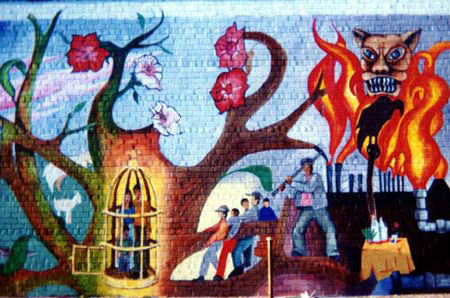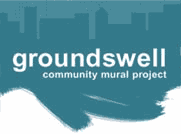

[2001-1996 Projects]
* Sunset Park Unity Mural
* Groundswell Summer...
* Scene Through a Fence
* Peace is Not A Dream...
* We are Here to...
* Paradise Lost and...
* Everyone Holds a World...
* How Our People Left...
How Our People Left Everything Behind to Struggle to Build...

HOW OUR PEOPLE LEFT EVERYTHING BEHIND TO STRUGGLE TO BUILD A BETTER LIFE ONLY TO FIND OURSELVES TRAPPED AND ISOLATED IN THE “GOLDEN BIRDCAGE”
Groundswell Community Mural Project ©
www.groundswellmural.org
Acrylic on Brick
16 x 36 Ft
1996
Artists: Amy Sananman, Albertano Meza
Location: Shufra Chocolate Factory, Union Avenue & Frost Street, Williamsburg, Brooklyn.
PROJECT DESCRIPTION
Groundswell’s first project organized Latino youth (ages 8 - 20) residing in adjacent buildings in Brooklyn, once owned by slumlords, but now owned and operated cooperatively by the young people's parents. Through numerous drawing sessions the group generated the mural's theme-How Our People Left Everything Behind to Struggle to Build a Better Life Only to Find Ourselves Trapped and Isolated in the "Golden Birdcage"- which deals with the complex sacrifices made by immigrant parents leaving their homeland to improve the lot of their children. The mural depicts a "Golden Birdcage" (a Mexican metaphor for the United States) imbedded in the trunk of a tree which at the center bears flowers, but on the periphery has burned branches.
The peripheral images are that of work: both in menacing industrial and demanding Mexican farm settings. Hands placing coins in a "tenement piggy-bank" and a traditional Mexican "memorial" table provide varied images of sacrifice. However, despite bleak and hard images of work and sacrifice, we see the "flowers" or beauty in the spirit of the sacrifices being made: for the love of family and children. The mural made a significant impact in the community. Polish and Italian neighbors as well as local graffiti artists stopped to talk with the boys about their work. In addition, the Latino youth interacted daily with the Hasidic owners and workers at the chocolate factory on which the mural was painted. This interaction grew into longer relationships in the form of summer and weekend jobs for some of the youth.
